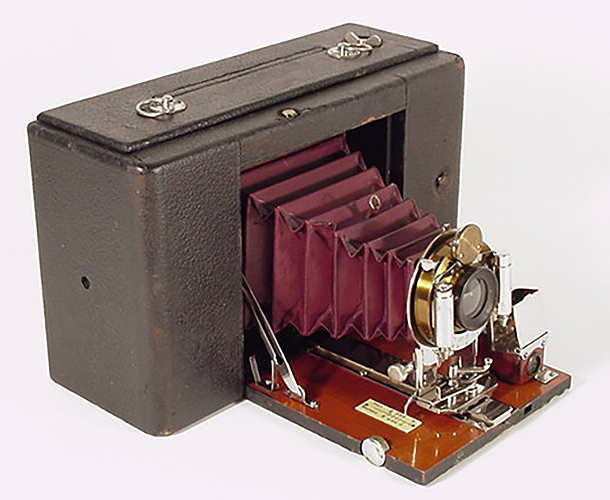
No. 7 Buckeye Camera

The American Camera Manufacturing Company No. 7 Buckeye camera dates to ca 1902. It is a wood-bodied folding-bed rollfilm camera with an interesting twist. Although the No. 7 Buckeye could be aimed with its waist-level brilliant viewfinder, and focus adjusted by setting a lens-standard pointer to an ivory distance scale, these features were not at all unusual. What makes this camera so fascinating is its facility for ground glass viewing and the unusual way this was carried out.
The No. 7 Buckeye employed a rollfilm chamber that was movable. To compose a photograph the chamber is moved up, out of the way of the rear ground glass viewing screen. It is set back into the camera body for exposure. This design allowed a non-reflex rollfilm camera to offer ground glass viewing without the necessity to fully remove and replace a roll-holder between exposures.
It is understandable that this unusual design attempted to marry the precision of ground glass viewing with the convenience of rollfilm. In the late 19th and early 20th centuries a variety of unusual camera types appeared on the market. This was a time of rapid change and experimentation in the photographic industry. Since the introduction of George Eastman's first rollfilm camera, the Kodak, in 1888, camera manufacturers and photographers were unsure what features would make for a perfect picture-taking instrument. Should rollfilm replace heavy and bulky glass plates? Should ground glass viewing, a near-perfect composition and focusing aid, be replaced by squinty little brilliant viewfinders and non-focusing lenses?
Two models of Buckeye cameras with this unique design were produced. The No. 7 takes 3 1/4 x 4 1/4 inch photographs on size 118 rollfilm. The larger No. 8 takes 4x5 inch exposures on size 103 rollfilm.
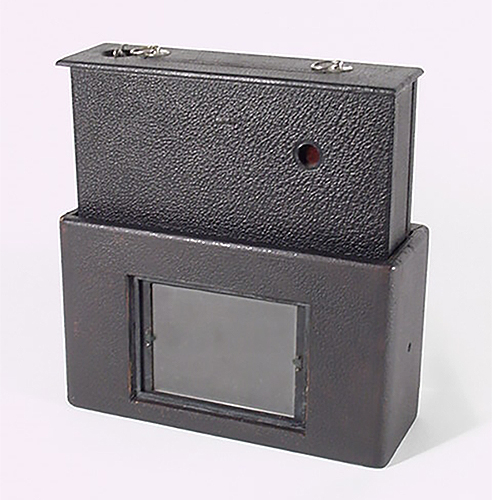
Rollfilm is loaded into the central chamber, seen in its raised position, above. With the film chamber in this position light from the lens can fall on the ground glass viewing screen. The ground glass frame is spring-loaded to move inward when the film chamber is raised. This is necessary because, for accurate focus, the ground glass needs to be located in the same position as the film.
A ruby window is used to count exposures. The ruby window is located in a panel that is removable for film loading.
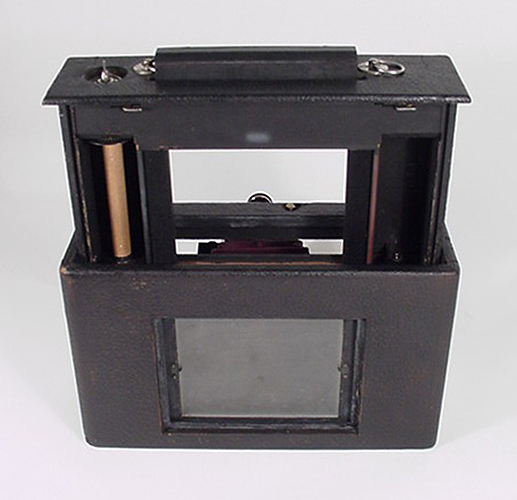
In this view of the No. 7 Buckeye the film chamber cover panel has been removed and the dark slide has been drawn. Stops prevent the slide from being pulled completely from the chamber. The slide lays over the top of the camera when raised because its midsection has a flexible tambour construction.
Actually, when loading film the dark slide should not be pulled out. The slide is to be drawn just before making an exposure, with the film chamber in its lowered position. The slide was raised to give a better view of the film chamber in this photograph.
Notice the empty wood-core film spool on the left. With the back panel removed a roll of fresh film is placed in the right side of the chamber and threaded onto the empty roll on the left. The back panel is replaced and the wind key, located on top of the camera, is revolved until the number 1 can be seen in the ruby window.
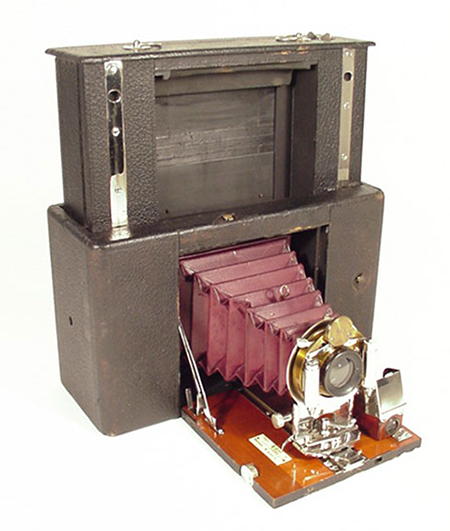
This view of the No. 7 Buckeye shows the camera's appearance as the subject is composed and focused on the ground glass. The lens has been pulled onto the track, the shutter is open on the time setting, and the film chamber is locked in its raised position. The film advance knob has been rotated until the next frame number is aligned in the red window. A focus adjustment knob can be seen set into the left edge of the baseboard. This knob is rotated while viewing the image on the rear ground glass screen.
To make an exposure, the film chamber is lowered back into the body, the shutter is closed, shutter speed and aperture are set, the film chamber dark slide is drawn out, and the shutter is released. Then the dark slide is slid back into the chamber.
Although this sequence of steps can be varied somewhat, forgetting a step or performing a critical step out of sequence would result in blank or double exposures. It took mental discipline to shoot a perfect roll of film with this camera.
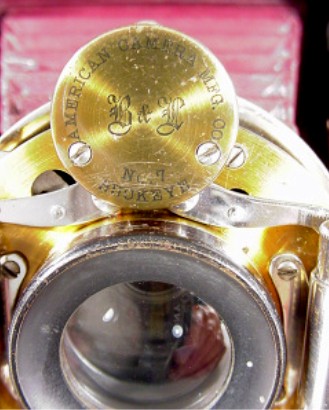
A nameplate above the lens identifies this camera as the No. 7 Buckeye. The letters B & L in its center are the initials of Bausch & Lomb Company, manufacturer of the lens and shutter.
The lens is an f/4 Rapid Rectilinear with stops to f/128. The pneumatic shutter offers speeds of 1 to 1/100 second, time and bulb.
The lens standard has rise and shift movements for image control.
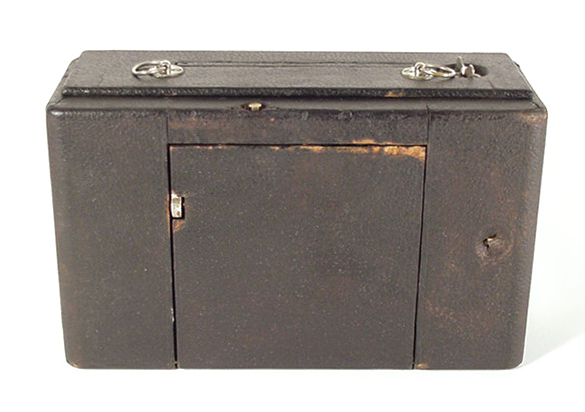
This is the how the camera looked when I first spotted it from across a room. Intuitively I knew this was no ordinary folding-bed camera. The visual clue was the thin panel on top. After two days of fruitless antique hunting this find was more than I had hoped for.
Notice a circular area in the leather to the right of the bed. This is the film chamber release button. Notice the two nickel rings on the camera top. At one time, a leather carrying strap was attached to the rings. When lowered, the film chamber is locked in position allowing the strap to be used to carry the camera. To raise the film chamber, the chamber release button is pushed, while pulling up on the strap.
A brass colored button can be seen on the top front edge of the body. This is the camera bed release button. Originally, both release buttons were concealed under the leather covering. It is fairly common in antique cameras to find this leather torn from fatigue.
Closed, the camera is 6 inches tall, 9 3/4 inches wide and 3 3/4 inches deep. Standard tripod sockets are provided for both horizontal and vertical mounting.
Thomas H. Blair was an early photographer turned inventor and manufacturer. A major player and force in the photographic industry of the late 1800s, Thomas Blair formed several companies to manufacture and sell cameras, film and photographic goods. Thomas Blair's biography can be pieced together from a variety of books and manuscripts, and it is as interesting as those of the other great pioneers of photography. But the story is a bit long and complex for this page.
Blair formed the American Camera Manufacturing Company, and the American Camera Company, a marketing firm, in 1896 in Northboro, Massachusetts. Blair sold both of these companies, along with European Blair Ltd. and the historically important David Houston front-mounted roll holder patents to George Eastman in January, 1898. During Blair's ownership, the American Camera Manufacturing Company manufactured Buckeye cameras.
George Eastman continued operating the American Camera Manufacturing Company as an independent entity until ca 1904. For a number of years thereafter, the organization operated as the American Camera Division of Eastman Kodak Company.
The American Camera Manufacturing Company, sometimes mistakenly confused with the American Optical Company, is one of the lesser-known early American camera manufacturers. ACM Company produced a small variety of well-made folding and box style cameras that were sold under the Buckeye trademark. ACM Company products were similar to cameras made by Blair's other company, Blair Camera Company. ACM Company cameras are not considered rare, but they are not as common as similar cameras sold by Blair Camera Company and other makers.
I rarely use the word rare, and I won't use it here, but the No. 7 and No. 8 Buckeye cameras can be very difficult to locate today. They were not made in great numbers. The example in my collection carries serial number 794.
Blair Camera Company made and sold two models that were probably identical to the No. 7 and No. 8 Buckeyes. These are the Focusing Weno Hawk-Eye No. 3 and No. 4 cameras.
The No.7 Buckeye carries two patent dates, but unfortunately neither of the associated patents relate to the unique roll-holder design. I am still hoping to locate a patent covering this design, and if one exists, I am curious to learn whether the inventor was Thomas Blair or another individual.
I highly recommend the book Anthony the Man the Company the Cameras by William and Estelle Marder, © 1982 for biographical information on Thomas H. Blair and for an authoritative, thoroughly researched look into the early developmental period of the American photographic industry. This book has served as my primary source of information on Thomas Blair and his companies.
A Blair Camera Company Hawk-Eye Detective camera is featured on this site.
Follow this link to see an Anthony & Scovill Ansco No. 7, a camera designed to take Ansco Vidil Focusing Film. Ansco Vidil film was another creative attempt at giving viewing screen capability to non-reflex rollfilm cameras. What is so interesting about this approach is the viewing screens were built into the film, not the camera!

|
Page created July 6. 2002; updated December 20, 2020
|